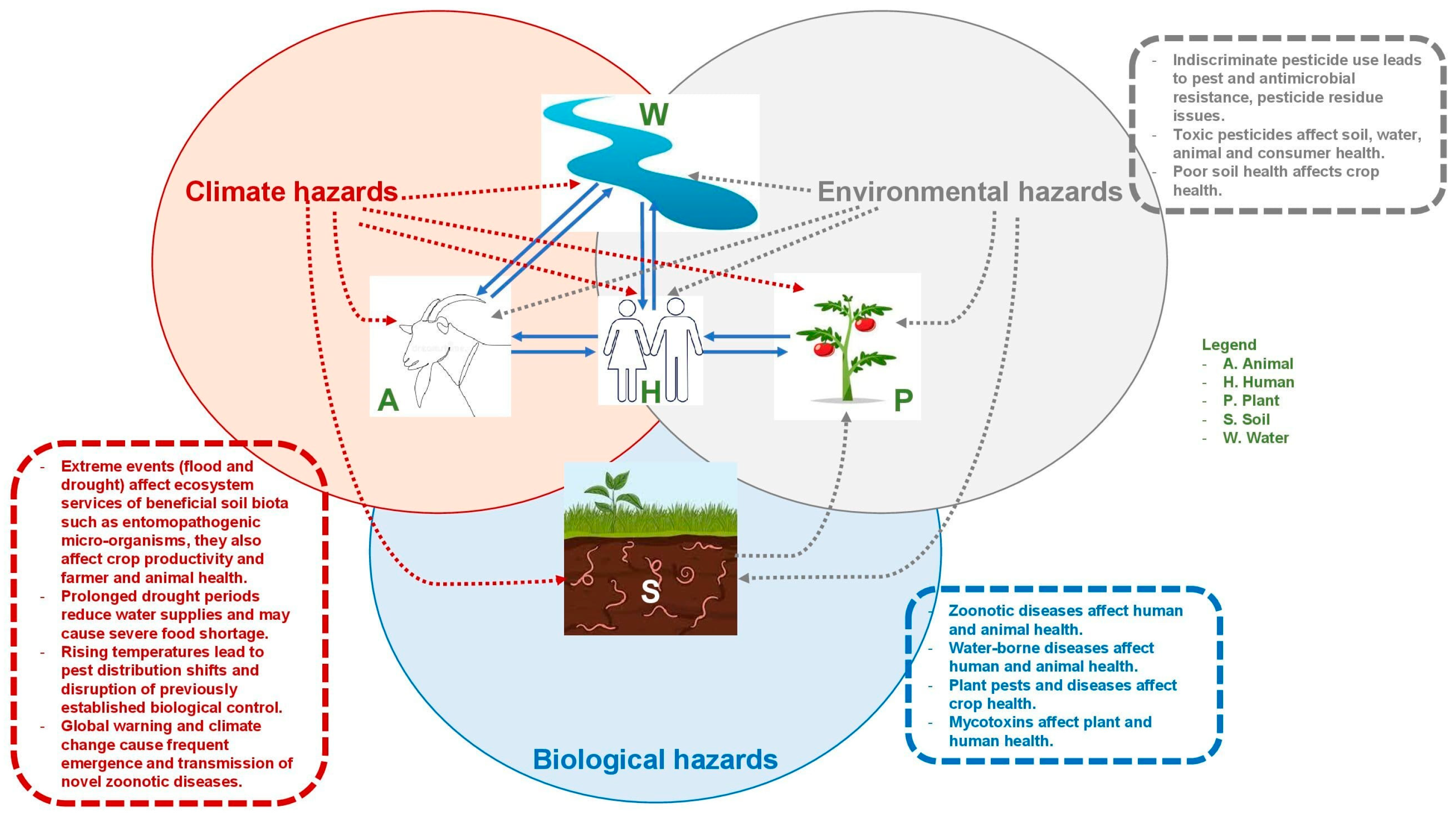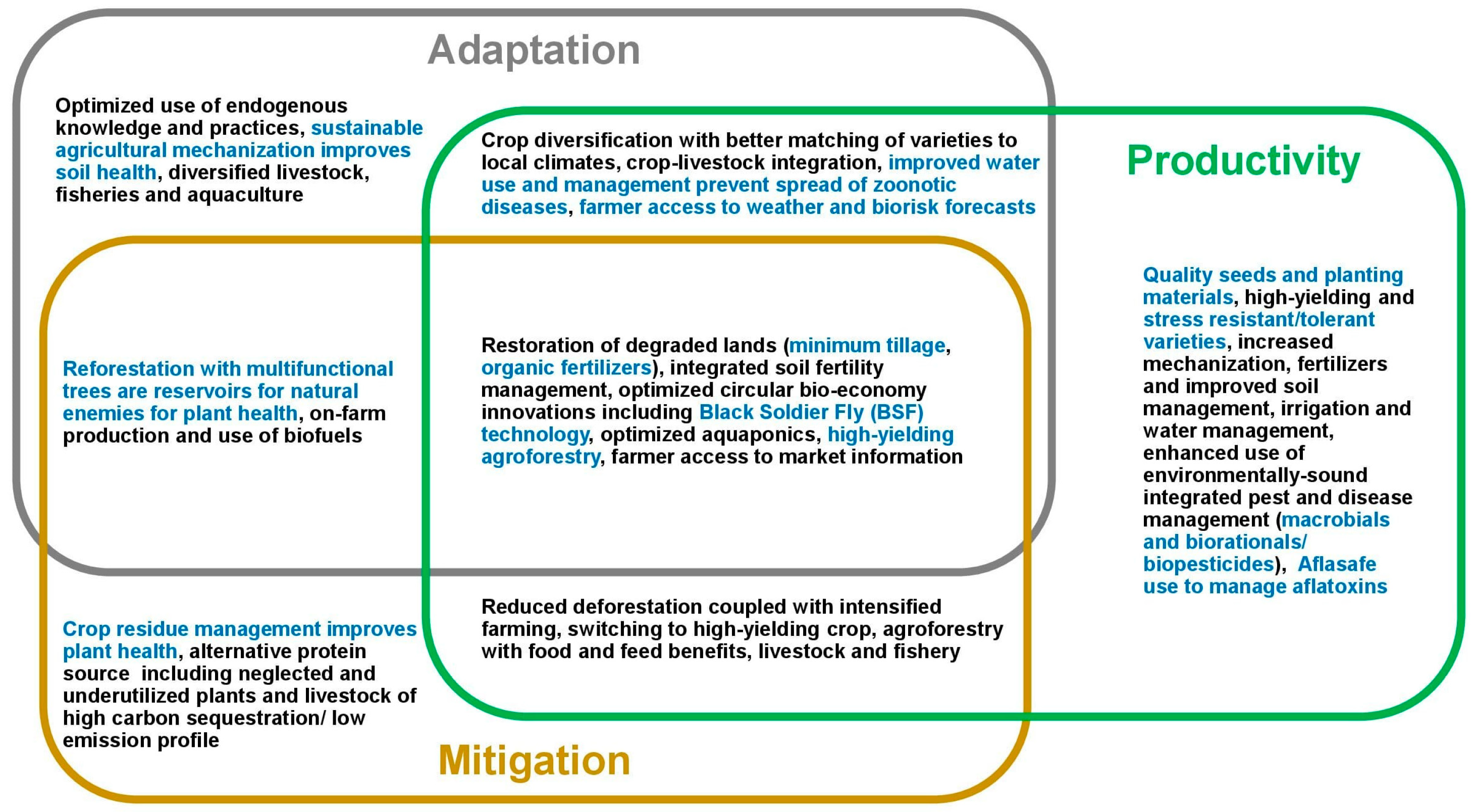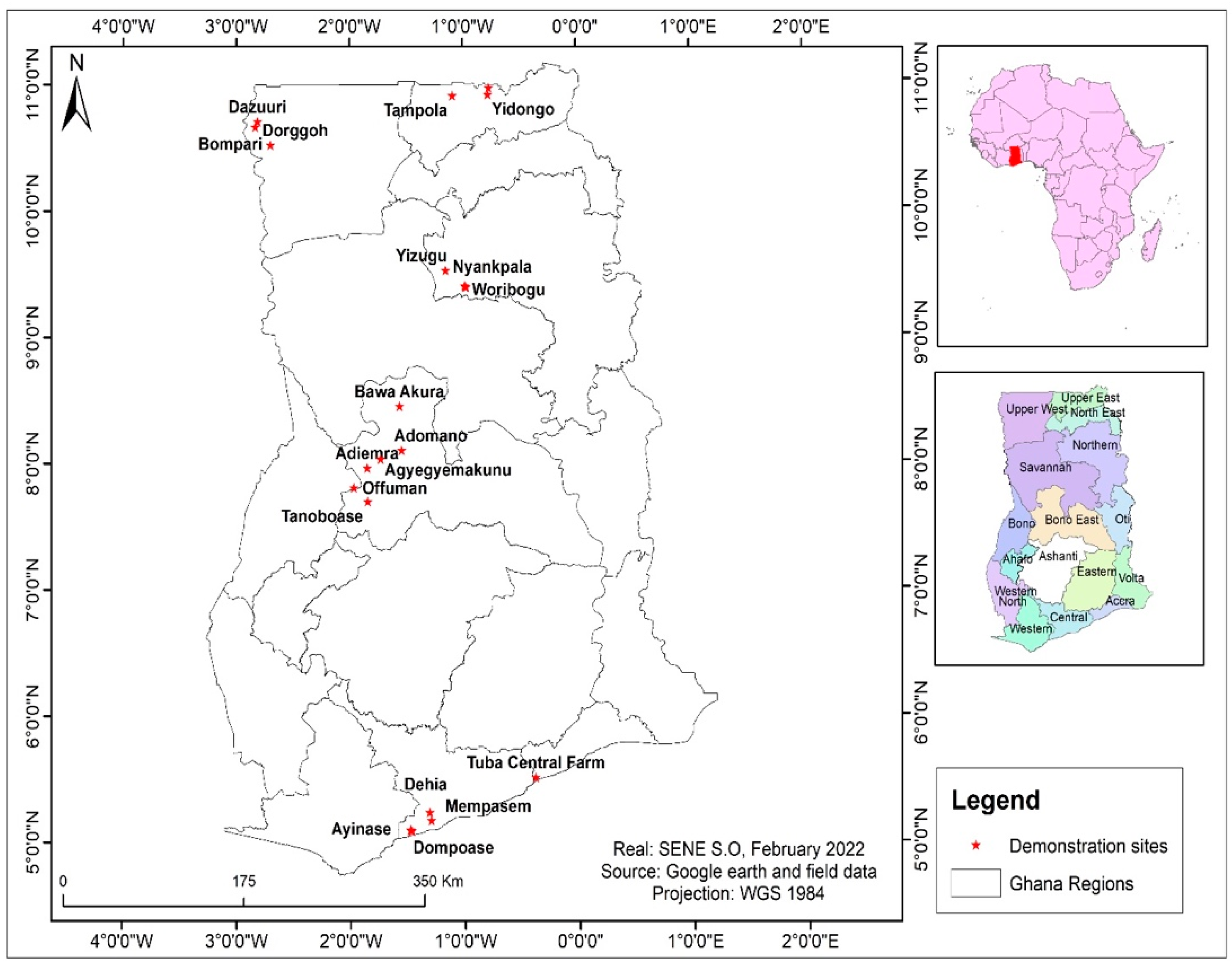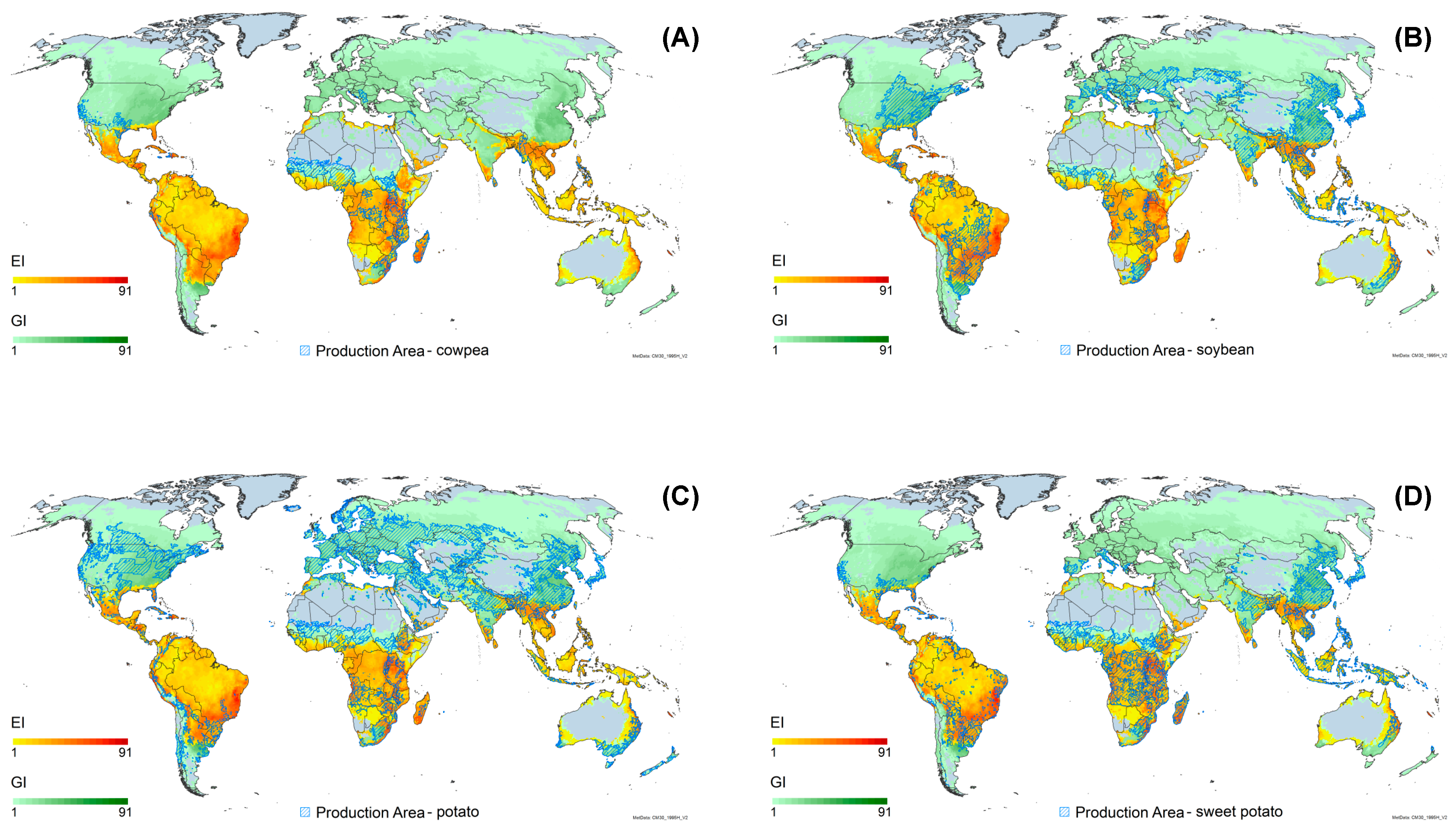Implementation Outline of Climate-Smart One Health: A System-Thinking Approach
Abstract
:1. Introduction
1.1. Context and Definitions
1.2. Advancing the One Health Concept: Addressing Challenges and Opportunities in a Changing World
1.3. Challenges of Climate Change and Weather Variability in Africa
1.4. Charting a Path towards Climate-Smart One Health and Integrated Pest Management
2. Materials and Methods
2.1. Concept and Data Requirements for CS-OH and CS-IPM
2.2. Design of Climate and Environmental Smartness of One Health
2.3. Core Pillars for Implementing Climate-Smart One Health
2.4. Scaling Climate-Smart One Health (CS-OH) Innovations in Ghana
3. Results
3.1. Achieving Climate Smartness and One Health Targets
3.2. Ghana: The Champion Country Implementing Climate-Smart One Health
3.3. Designing Climate-Smart Integrated Pest Management (CS-IPM) in Ghana
3.4. Making a Case for Climate-Smart Integrated Pest Management (CS-IPM)
3.5. Climate-Smart Agriculture (CSA) Options with IPM Co-Benefits
- Developing climate-informed models for assessing pest risks, identifying potential natural enemies, and enabling forecasting and continuous monitoring. This involves the establishment of technical advisory extension services and harmonized protocols, along with the prioritization of impactful pest management options.
- Ensuring timely detection and proactive measures against invasive species and potential pests exacerbated by climate change.
- Strengthening the capabilities of governmental pest management structures, frontline farmers, and other end-users in effectively reporting, anticipating, and proactively responding to pest- and disease-related challenges.
- Refining and piloting evidence-based innovations and promoting the adoption of digital tools, including Apps-led pest scouting and warning devices.
- Fostering collaboration to establish sustainable business models for pest management services and engaging the private sector to ensure the effective deployment of impactful products and tools. This empowerment initiative should particularly target youth and female farmers.
- Engaging policymakers to create a legislative framework that promotes responsible chemical use and enforces stringent measures against the abusive or unauthorized use of chemicals, especially those that are prohibited and highly toxic to the environment, with significant non-target effects.
- Accelerating the co-development and coordination of functional local and regional early warning and rapid response systems to address pest and disease invasions effectively.
3.6. Early Warning and Rapid Response System for Pests and Diseases (EWRRS-PD)
3.7. Stakeholder Mapping for Ghana EWRRS-PD
- Reporting
- Risk knowledge generation
- Risk mitigation
- Risk communication
- Monitoring and warning
- Risk assessment
- Risk and response dissemination
- Recycling and capacity strengthening
4. Discussion
5. Conclusions
- The interconnectedness between soil, water, plants, animals and humans as core elements of a One Health 2.0 model;
- A super ambitious and creative Climate-Smart One Health (CS-OH) framework to address complex climate–OH nexus risks in agrifood systems;
- The basic pillars of Climate-Smart Integrated Pest Management (CS-IPM);
- The investment requirements for both approaches: CS-OH and CS-IPM.
- Step 1—OH 2.0 problem characterization, prediction analysis, alerts and demand scope evaluation, government call for action or emergencies to manage OH 2.0 issues.
- Step 2—Mapping of local, national or regional capacity (public and private sectors) on OH 2.0.
- Step 3—Launch of institutional process and stakeholder consultations to agree on lead organization, core strategies, coordination mechanisms, communication tools and channels, and monitoring, evaluation, learning and impact assessment (MELIA) tools, approaches and plans.
- Step 4—Identification of existing and required expertise across the core disciplines of OH 2.0: soil, water and plant health, feed, food and nutritional safety, veterinary and public health, and climate science.
- Step 5—Comprehensive biological- (crop and animal pests and diseases, human infectious or zoonotic diseases), environmental- (hazardous use of pesticides and other agrochemicals) and climate (climate variability and change impacts)-related health risk mapping, assessment and prioritization in target agrifood systems.
- Step 6—Geographic scoping, mapping and prioritization of scalable impactful Climate-Smart Agriculture (CSA) and other relevant solutions to tackle the health risks identified in step 5.
- Step 7—Design of priority OH 2.0 solutions, integrations or bundles and development of dissemination and scaling models.
- Step 8—Baseline survey, solution deployment and monitoring, evaluation, learning and impact assessment (MELIA).
Author Contributions
Funding
Institutional Review Board Statement
Informed Consent Statement
Data Availability Statement
Acknowledgments
Conflicts of Interest
References
- Nzietchueng, S.; Kitua, A.; Nyatanyi, T.; Rwego, I.B. Facilitating implementation of the one health approach: A definition of a one health intervention. One Health 2023, 16, 100491. [Google Scholar] [CrossRef] [PubMed]
- Sitko, N.; Knowles, M.; Viberti, F.; Bordi, D. Assessing the Impacts of the COVID-19 Pandemic on the Livelihoods of Rural People—A Review of the Evidence; FAO: Rome, Italy, 2022. [Google Scholar] [CrossRef]
- Kumari, S.; Venkatesh, V.G.; Shi, Y. Assessment of Risks and Risk Management for Agriculture Supply Chain. In Supply Chain Risk and Disruption Management. Flexible Systems Management; Paul, S.K., Agarwal, R., Sarker, R.A., Rahman, T., Eds.; Springer: Singapore, 2023. [Google Scholar] [CrossRef]
- Gupta, H.; Kharub, M.; Shreshth, K.; Kumar, A.; Huisingh, D.; Kumar, A. Evaluation of strategies to manage risks in smart, sustainable agri-logistics sector: A Bayesian-based group decision-making approach. Bus. Strategy Environ. 2023, 32, 4335–4359. [Google Scholar] [CrossRef]
- Buschhardt, T.; Günther, T.; Skjerdal, T.; Torpdahl, M.; Gethmann, J.; Filippitzi, M.-E.; Maassen, C.; Jore, S.; Ellis-Iversen, J.; Filter, M.; et al. A one health glossary to support communication and information exchange between the human health, animal health and food safety sectors. One Health 2021, 13, 100263. [Google Scholar] [CrossRef]
- US Departments of Agriculture. One Heath Definition. 2016. Available online: https://www.usda.gov/sites/default/files/documents/fact-sheet-one-health-06-16-2016.pdf (accessed on 9 July 2024).
- One Health Commission. One Health Definition. Available online: https://www.onehealthcommission.org/en/why_one_health/what_is_one_health/ (accessed on 9 July 2024).
- US Centers for Disease Control and Prevention. One Health Definition. Available online: https://www.cdc.gov/one-health/about/index.html (accessed on 9 July 2024).
- One Health High-Level Expert Panel (OHHLEP); Adisasmito, W.B.; Almuhairi, S.; Behravesh, C.B.; Bilivogui, P.; Bukachi, S.A.; Casas, N.; Becerra, N.C.; Charron, D.F.; Chaudhary, A.; et al. One Health: A new definition for a sustainable and healthy future. PLoS Pathog. 2022, 18, e1010537. [Google Scholar] [CrossRef]
- Mora, C.; McKenzie, T.; Gaw, I.M.; Dean, J.M.; von Hammerstein, H.; Knudson, T.A.; Setter, R.O.; Smith, C.Z.; Webster, K.M.; Patz, J.A.; et al. Over half of known human pathogenic diseases can be aggravated by climate change. Nat. Clim. Change 2022, 12, 869–875. [Google Scholar] [CrossRef]
- Azadi, H.; Moghaddam, S.M.; Burkart, S.; Mahmoudi, H.; Van Passel, S.; Kurban, A.; Lopez-Carr, D. Rethinking resilient agriculture: From climate-smart agriculture to vulnerable-smart agriculture. J. Clean. Prod. 2021, 319, 128602. [Google Scholar] [CrossRef]
- Ahmad, T.; Baig, M.; Hui, J. Coronavirus disease 2019 (COVID-19) pandemic and economic impact. Pak. J. Med. Sci. 2020, 36, S73–S78. [Google Scholar] [CrossRef]
- Thakur, S.D. Early Warning Systems, Disease Management, and Biosecurity in Disasters. In Management of Animals in Disasters; Verma, S., Prem, H.T., Eds.; Springer: Singapore, 2022. [Google Scholar] [CrossRef]
- Wang, C.-X.; Xiu, L.-S.; Hu, Q.-Q.; Lee, T.-C.; Liu, J.; Shi, L.; Zhou, X.-N.; Guo, X.-K.; Hou, L.; Yin, K. Advancing early warning and surveillance for zoonotic diseases under climate change: Interdisciplinary systematic perspectives. Adv. Clim. Change Res. 2023, 14, 814–826. [Google Scholar] [CrossRef]
- Buchaillot, M.L.; Cairns, J.; Hamadziripi, E.; Wilson, K.; Hughes, D.; Chelal, J.; McCloskey, P.; Kehs, A.; Clinton, N.; Araus, J.L.; et al. Regional monitoring of fall armyworm (FAW) using early warning systems. Remote Sens. 2022, 14, 5003. [Google Scholar] [CrossRef]
- Galaz, V.; Leach, M.; Scoones, I.; Stein, C. Political Economy of One Health Research and Policy. 2015. Available online: https://steps-centre.org/wp-content/uploads/One-Health-wp3.pdf (accessed on 5 May 2024).
- Wilkes, M.; Papageorgiou, S.; Kim, T.Y.; Baldrias, L.; Aguilar, E.; Kelly, T.; Tee, M. One Health Workers: Innovations in Early Detection of Human, Animal, and Plant Disease Outbreaks. J. Glob. Health Rep. 2019, 3, e2019093. [Google Scholar] [CrossRef]
- Lim, S.C.; Knight, D.R.; Riley, T.V. Clostridium difficile and One Health. Clin. Microbiol. Infect. 2020, 26, 857–863. [Google Scholar] [CrossRef] [PubMed]
- Zinsstag, J.; Crump, L.; Schelling, E.; Hattendorf, J.; Maidane, Y.O.; Ali, K.O.; Muhummed, A.; Umer, A.A.; Aliyi, F.; Nooh, F.; et al. Climate Change and One Health. FEMS Microbiol. Lett. 2018, 365, fny085. [Google Scholar] [CrossRef] [PubMed]
- Kelly, T.R.; Machalaba, C.; Karesh, W.B.; Crook, P.Z.; Gilardi, K.; Nziza, J.; Uhart, M.M.; Robles, E.A.; Saylors, K.; Joly, D.O.; et al. Implementing One Health Approaches to Confront Emerging and Re-Emerging Zoonotic Disease Threats: Lessons from PREDICT. One Health Outlook 2020, 2, 1. [Google Scholar] [CrossRef] [PubMed]
- Lombi, E.; Donner, E.; Dusinska, M.; Wickson, F. A One Health Approach to Managing the Applications and Implications of Nanotechnologies in Agriculture. Nat. Nanotechnol. 2019, 14, 523–531. [Google Scholar] [CrossRef] [PubMed]
- Hilborn, E.D.; Beasley, V.R. One health and cyanobacteria in freshwater systems: Animal illnesses and deaths are sentinel events for human health risks. Toxins 2015, 7, 1374–1395. [Google Scholar] [CrossRef] [PubMed]
- van Bruggen, A.H.; Goss, E.M.; Havelaar, A.; van Diepeningen, A.D.; Finckh, M.R.; Morris, J.G., Jr. One Health-Cycling of diverse microbial communities as a connecting force for soil, plant, animal, human and ecosystem health. Sci. Total Environ. 2019, 664, 927–937. [Google Scholar] [CrossRef] [PubMed]
- Yeh, K.B.; Fair, J.M.; Smith, W.; Martinez Torres, T.; Lucas, J.; Monagin, C.; Winegar, R.; Fletcher, J. Assessing climate change impact on ecosystems and infectious disease: Important roles for genomic sequencing and a one health perspective. Trop. Med. Infect. Dis. 2020, 5, 90. [Google Scholar] [CrossRef] [PubMed]
- Prata, J.C.; da Costa, J.P.; Lopes, I.; Andrady, A.L.; Duarte, A.C.; Rocha-Santos, T. A One Health perspective of the impacts of microplastics on animal, human and environmental health. Sci. Total Environ. 2021, 777, 146094. [Google Scholar] [CrossRef]
- Sekabira, H.; Tepa-Yotto, G.T.; Kaweesa, Y.; Simbeko, G.; Tamò, M.; Agboton, C.; Tahidu, O.D.; Abdoulaye, T. Impact of CS-IPM on Key Social Welfare Aspects of Smallholder Farmers’ Livelihoods. Climate 2023, 11, 97. [Google Scholar] [CrossRef]
- Panagopoulos, D.J.; Cammaerts, M.C.; Favre, D.; Balmori, A. Comments on Environmental Impact of Radiofrequency Fields from Mobile Phone Base Stations. Crit. Rev. Environ. Sci. Technol. 2016, 46, 885–903. [Google Scholar] [CrossRef]
- Geneletti, D.; Cortinovis, C.; Zardo, L.; Adem Esmail, B. Reviewing Ecosystem Services in Urban Climate Adaptation Plans. Land Use Policy 2020, 70, 298–312. [Google Scholar] [CrossRef]
- Everard, M.; Johnston, P.; Santillo, D.; Staddon, C. The role of ecosystems in mitigation and management of COVID-19 and other zoonoses. Environ. Sci. Policy 2020, 111, 7–17. [Google Scholar] [CrossRef] [PubMed]
- Keesing, F.; Ostfeld, R.S. Impacts of biodiversity and biodiversity loss on zoonotic diseases. Proc. Natl. Acad. Sci. USA 2021, 118, e2023540118. [Google Scholar] [CrossRef] [PubMed]
- Adla, K.; Dejan, K.; Neira, D.; Dragana, Š. Degradation of ecosystems and loss of ecosystem services. In One Health; Academic Press: Cambridge, MA, USA, 2022; pp. 281–327. [Google Scholar]
- Tazerji, S.S.; Nardini, R.; Safdar, M.; Shehata, A.A.; Duarte, P.M. An overview of anthropogenic actions as drivers for emerging and re-emerging zoonotic diseases. Pathogens 2022, 11, 1376. [Google Scholar] [CrossRef] [PubMed]
- Zhang, D.; Yang, Y.; Li, M.; Lu, Y.; Liu, Y.; Jiang, J.; Liu, R.; Liu, J.; Huang, X.; Li, G.; et al. Ecological barrier deterioration driven by human activities poses fatal threats to public health due to emerging infectious diseases. Engineering 2022, 10, 155–166. [Google Scholar] [CrossRef]
- Glidden, C.K.; Nova, N.; Kain, M.P.; Lagerstrom, K.M.; Skinner, E.B.; Mandle, L.; Sokolow, S.H.; Plowright, R.K.; Dirzo, R.; De Leo, G.A.; et al. Human-Mediated Impacts on Biodiversity and the Consequences for Zoonotic Disease Spillover. Curr. Biol. 2021, 31, R1342–R1361. [Google Scholar] [CrossRef] [PubMed]
- Plowright, R.K.; Reaser, J.K.; Locke, H.; Woodley, S.J.; Patz, J.A.; Becker, D.J.; Oppler, G.; Hudson, P.J.; Tabor, G.M. Land Use-Induced Spillover: A Call to Action to Safeguard Environmental, Animal, and Human Health. Lancet Planet. Health 2021, 5, e237–e245. [Google Scholar] [CrossRef] [PubMed]
- Garcia, C.D.L.; De Abreu, L.C.; Ramos, J.L.S.; De Castro, C.F.D.; Smiderle, F.R.N.; Dos Santos, J.A.; Bezerra, I.M.P. Influence of Burnout on Patient Safety: Systematic Review and Meta-Analysis. Medicina 2019, 55, 553. [Google Scholar] [CrossRef] [PubMed]
- Mayhew, S.; Hanefeld, J. Planning Adaptive Health Systems: The Climate Challenge. Lancet Glob. Health 2014, 2, e625–e626. [Google Scholar] [CrossRef]
- Ntajal, J.; Höllermann, B.; Falkenberg, T.; Kistemann, T.; Evers, M. Water and Health Nexus—Land Use Dynamics, Flooding, and Water-Borne Diseases in the Odaw River Basin, Ghana. Water 2022, 14, 461. [Google Scholar] [CrossRef]
- Stikeleather, J.; Masys, A.J. Global Health Security Innovation. In Global Health Security; Springer: Cham, Switzerland, 2020; ISBN 9783030234911. [Google Scholar]
- Srivastava, A. Assessing the Potential of AI—ML in Urban Climate Change Adaptation and Sustainable Development. Sustainability 2023, 15, 16461. [Google Scholar] [CrossRef]
- Simbanegavi, W. Expediting Growth and Development: Policy Challenges Confronting Africa. J. Dev. Perspect. 2019, 3, 18–23. [Google Scholar] [CrossRef]
- Skendžić, S.; Zovko, M.; Živković, I.P.; Lešić, V.; Lemić, D. The Impact of Climate Change on Agricultural Insect Pests. Insects 2021, 12, 440. [Google Scholar] [CrossRef] [PubMed]
- Tonnang, H.E.; Salifu, D.; Mudereri, B.T.; Tanui, J.; Espira, A.; Dubois, T.; Abdel-Rahman, E.M. Advances in Data-Collection Tools and Analytics for Crop Pest and Disease Management. Curr. Opin. Insect Sci. 2022, 54, 10–12. [Google Scholar] [CrossRef] [PubMed]
- Akinbile, C.O.; Ogunmola, O.O.; Abolude, A.T.; Akande, S.O. Trends and spatial analysis of temperature and rainfall patterns on rice yields in Nigeria. Atmos. Sci. Lett. 2020, 21, e944. [Google Scholar] [CrossRef]
- Bedeke, S.B. Climate change vulnerability and adaptation of crop producers in sub-Saharan Africa: A review on concepts, approaches and methods. Environ. Dev. Sustain. 2023, 25, 1017–1051. [Google Scholar] [CrossRef]
- Omotoso, A.B.; Letsoalo, S.; Olagunju, K.O.; Tshwene, C.S.; Omotayo, A.O. Climate change and variability in sub-Saharan Africa: A systematic review of trends and impacts on agriculture. J. Clean. Prod. 2023, 414, 137487. [Google Scholar] [CrossRef]
- Etukudoh, E.A.; Ilojianya, V.I.; Ayorinde, O.B.; Daudu, C.D.; Adefemi, A.; Hamdan, A. Review of climate change impact on water availability in the USA and Africa. Int. J. Sci. Res. Arch. 2024, 11, 942–951. [Google Scholar] [CrossRef]
- Sileshi, G.W.; Gebeyehu, S.; Mafongoya, P.L. The Threat of Alien Invasive Insect and Mite Species to Food Security in Africa and the Need for a Continent-Wide Response. Food Secur. 2019, 11, 763–775. [Google Scholar] [CrossRef]
- Kriticos, D.J.; Leriche, A.; Palmer, D.J.; Cook, D.C.; Brockerhoff, E.G.; Stephens, A.E.A.; Watt, M.S. Linking Climate Suitability, Spread Rates and Host-Impact When Estimating the Potential Costs of Invasive Pests. PLoS ONE 2013, 8, e54861. [Google Scholar] [CrossRef]
- Gentili, R.; Schaffner, U.; Martinoli, A.; Citterio, S. Invasive Alien Species and Biodiversity: Impacts and Management. Biodiversity 2021, 22, 1–3. [Google Scholar] [CrossRef]
- Timilsena, B.P.; Niassy, S.; Kimathi, E.; Abdel-Rahman, E.M.; Seidl-Adams, I.; Wamalwa, M.; Tonnang, H.E.Z.; Ekesi, S.; Hughes, D.P.; Rajotte, E.G.; et al. Potential distribution of fall armyworm in Africa and beyond, considering climate change and irrigation patterns. Sci. Rep. 2022, 12, 539. [Google Scholar] [CrossRef] [PubMed]
- Dong, Z.; He, Y.; Ren, Y.; Wang, G.; Chu, D. Seasonal and year-round distributions of Bactrocera dorsalis (Hendel) and its risk to temperate fruits under climate change. Insects 2022, 13, 550. [Google Scholar] [CrossRef] [PubMed]
- Cuthbert, R.N.; Diagne, C.; Haubrock, P.J.; Turbelin, A.J.; Courchamp, F. Are the “100 of the world’s worst” invasive species also the costliest? Biol. Invasions 2022, 24, 1895–1904. [Google Scholar] [CrossRef]
- Amusan, L. Climate Change, COVID-19 and Food Insecurity in Africa: A New Normal Approach. J. Meteorol. Clim. Sci. 2020, 18, 24–39. [Google Scholar]
- Meo, S.A.; Abukhalaf, A.A.; Alomar, A.A.; Aljudi, T.W.; Bajri, H.M.; Sami, W.; Akram, J.; Akram, S.J.; Hajjar, W. Impact of weather conditions on incidence and mortality of COVID-19 pandemic in Africa. Eur. Rev. Med. Pharmacol. Sci. 2020, 24, 9753–9759. [Google Scholar] [PubMed]
- Metelmann, S.; Pattni, K.; Brierley, L.; Cavalerie, L.; Caminade, C.; Blagrove, M.S.C.; Turner, J.; Sharkey, K.J.; Baylis, M. Impact of climatic, demographic and disease control factors on the transmission dynamics of COVID-19 in large cities worldwide. One Health 2021, 12, 100221. [Google Scholar] [CrossRef] [PubMed]
- Boufekane, A.; Busico, G.; Maizi, D. Effects of temperature and relative humidity on the COVID-19 pandemic in different climates: A study across some regions in Algeria (North Africa). Environ. Sci. Pollut. Res. 2021, 29, 18077–18102. [Google Scholar] [CrossRef]
- Tong, S.; Ebi, K.; Olsen, J. Infectious disease, the climate, and the future. Environ. Epidemiol. 2021, 5, e133. [Google Scholar] [CrossRef]
- Arotolu, T.E.; Afe, A.E.; Wang, H.; Lv, J.; Shi, K.; Huang, L.; Wang, X. Spatial modeling and ecological suitability of monkeypox disease in Southern Nigeria. PLoS ONE 2022, 17, e0274325. [Google Scholar] [CrossRef]
- Ateudjieu, J.; Siewe Fodjo, J.N.; Ambomatei, C.; Tchio-Nighie, K.H.; Zoung Kanyi Bissek, A.C. Zoonotic Diseases in Sub-Saharan Africa: A Systematic Review and Meta-Analysis. Zoonotic Dis. 2023, 3, 251–265. [Google Scholar] [CrossRef]
- Chemison, A.; Ramstein, G.; Jones, A.; Morse, A.; Caminade, C. Ability of a dynamical climate sensitive disease model to reproduce historical Rift Valley Fever outbreaks over Africa. Sci. Rep. 2024, 14, 3904. [Google Scholar] [CrossRef] [PubMed]
- Tonnang, H.E.Z.; Hervé, B.D.B.; Biber-Freudenberger, L.; Salifu, D.; Subramanian, S.; Ngowi, V.B.; Guimapi, R.Y.A.; Anani, B.; Kakmeni, F.M.M.; Affognon, H.; et al. Advances in Crop Insect Modelling Methods—Towards a Whole System Approach. Ecol. Modell. 2017, 354, 88–103. [Google Scholar] [CrossRef]
- Sterman, J. Business Dynamics Systems Thinking and Modeling for a Complex World. Jeffrey, J., Ed.; Shelsfud Senior: Cambridge, MA, USA, 2004; Volume 34, ISBN 007238915X. [Google Scholar]
- Intergovernmental Panel on Climate Change (IPCC). Climate Change 2021—The Physical Science Basis; Cambridge University Press: Cambridge, UK, 2021. [Google Scholar]
- Sterling, E.J.; Pascua, P.; Sigouin, A.; Gazit, N.; Mandle, L.; Betley, E.; Aini, J.; Albert, S.; Caillon, S.; Caselle, J.E.; et al. Creating a Space for Place and Multidimensional Well-Being: Lessons Learned from Localizing the SDGs. Sustain. Sci. 2020, 15, 1129–1147. [Google Scholar] [CrossRef]
- Paz, D.B.; Henderson, K.; Loreau, M. Agricultural land use and the sustainability of social-ecological systems. Ecol. Model. 2020, 437, 109312. [Google Scholar]
- Millard, J.; Outhwaite, C.L.; Kinnersley, R.; Freeman, R.; Gregory, R.D.; Adedoja, O.; Gavini, S.; Kioko, E.; Kuhlmann, M.; Ollerton, J.; et al. Global effects of land-use intensity on local pollinator biodiversity. Nat. Commun. 2021, 12, 2902. [Google Scholar] [CrossRef] [PubMed]
- Feng, S.J.; Chen, B.X.; Liu, Y.H. Effects of land use intensity change on biodiversity in agricultural areas. J. Ecol. Rural Environ. 2021, 37, 1271–1280. [Google Scholar]
- Traore, T.; Shanks, S.; Haider, N.; Ahmed, K.; Jain, V.; Rüegg, S.R.; Razavi, A.; Kock, R.; Erondu, N.; Rahman-Shepherd, A.; et al. How prepared is the world? Identifying weaknesses in existing assessment frameworks for global health security through a One Health approach. Lancet 2023, 401, 673–687. [Google Scholar] [CrossRef]
- Magnano San Lio, R.; Favara, G.; Maugeri, A.; Barchitta, M.; Agodi, A. How antimicrobial resistance is linked to climate change: An overview of two intertwined global challenges. Int. J. Environ. Res. Public Health 2023, 20, 1681. [Google Scholar] [CrossRef]
- Liao, H.; Lyon, C.J.; Ying, B.; Hu, T. Climate Change, Its Impact on Emerging Infectious Diseases and New Technologies to Combat the Challenge. Emerg. Microbes Infect. 2024. just-accepted. [Google Scholar] [CrossRef]
- Sekabira, H.; Tepa-Yotto, G.T.; Tamò, M.; Djouaka, R.; Dalaa, M.; Damba, O.T.; Yeboah, S.; Obeng, F.; Asare, R.; Abdoulaye, T.; et al. Socio-Economic Determinants for the Deployment of Climate-Smart One-Health Innovations. A Meta-Analysis Approach Prioritizing Ghana and Benin. PLoS Sustain. Transform. 2023, 2, e0000052. [Google Scholar] [CrossRef]
- Eschen, R.; Beale, T.; Bonnin, J.M.; Constantine, K.L.; Duah, S.; Finch, E.A.; Makale, F.; Nunda, W.; Ogunmodede, A.; Pratt, C.F.; et al. Towards Estimating the Economic Cost of Invasive Alien Species to African Crop and Livestock Production. CABI Agric. Biosci. 2021, 2, 18. [Google Scholar] [CrossRef]
- Tepa-Yotto, G.T.; Gouwakinnou, G.N.; Fagbohoun, J.R.; Tamò, M.; Sæthre, M.G. Horizon Scanning to Assess the Bioclimatic Potential for the Alien Species Spodoptera Eridania and Its Parasitoids after Pest Detection in West and Central Africa. Pest Manag. Sci. 2021, 77, 4437–4446. [Google Scholar] [CrossRef] [PubMed]
- Weinberg, J.; Ota, N.; Goergen, G.; Fagbohoun, J.R.; Tepa-Yotto, G.T.; Kriticos, D.J. Spodoptera Eridania: Current and Emerging Crop Threats from Another Invasive, Pesticide-Resistant Moth. Entomol. Gen. 2022, 42, 701–712. [Google Scholar] [CrossRef]
- Lipper, L.; Thornton, P.K.; Campbell, B.M.; Baedeker, T. Climate-Smart Agriculture for Food Security. Nat. Clim. Change 2014, 4, 1068–1072. [Google Scholar] [CrossRef]
- Häsler, B.; Cornelsen, L.; Bennani, H.; Rushton, J. A Review of the Metrics for One Health Benefits. OIE Rev. Sci. Tech. 2014, 33, 453–464. [Google Scholar] [CrossRef]







| Climate-Smart Agriculture Target | Level of CSA Investment Required * | One Health Gains Likelihood |
|---|---|---|
| Productivity | Low | Medium |
| Mitigation | Low | Low |
| Adaptation | Low | Low |
| Productivity–Mitigation | Medium | Medium |
| Productivity–Adaptation | Medium | High |
| Mitigation–Adaptation | Medium | Medium |
| Productivity–Mitigation–Adaptation | High | High |
| Number of One Health Components Implemented | Associated CSA Investment Requirement | One Health Outcome Achievement Level |
|---|---|---|
| Single One Health component * | Low | Nil |
| Two interconnected One Health components | Medium | Low |
| Three interconnected One Health components ** | Medium to High | Medium to High |
| More than three interconnected One Health components ** | High | High |
| CSA-CIS Options | Target One Health Response |
|---|---|
| Use of biorationals (low toxicity pesticides) and biopesticides | Improved plant health Preserved soil–water–animal–human health |
| Aflasafe (plant bioprotectant against aflatoxins) | Improved plant health (post-harvest) Preserved animal–human health |
| Minimum tillage | Improved soil health |
| Organic fertilizers | Improved soil health |
| Quality vines and seed yam | Improved plant–animal health |
| Circular bioeconomy-based Black Soldier Fly (BSF) technology (organic waste degradation into organic fertilizers and larval feed for fish and poultry) | Improved plant–soil–water–animal–human health |
| Farmer-led irrigation | Improved water management/health |
| Pest-resistant/tolerant varieties | Improved plant–human–animal–ecosystem health |
| Smart and drought-tolerant varieties | Improved water management Pest and Striga tolerant Preserved soil health |
| Agroforestry | Improved plant and soil health |
| Climate and risk information services and advisories | Preserved plant–soil–water–animal–human health |
| Host | Invasive Alien Species | Yield Loss Value (Billions, USD) |
|---|---|---|
| Maize | Spodoptera frugiperda | 7.7–12.1 |
| Prostephanus truncatus | 0.2–0.3 | |
| Chilo partellus | 2.1–3.1 | |
| Cassava | Phenacoccus manihoti | 5.5–7.3 |
| Mangoes | Bactrocera dorsalis | 3.5–5.8 |
| Total (billions, USD) | 18.2–29.1 |
| Country | Economic Cost (Millions, USD) | ||||
|---|---|---|---|---|---|
| Spodoptera frugiperda | Prostephanus truncatus | Chilo partellus | Phenacoccus manihoti | Bactrocera dorsalis | |
| Burkina Faso | 186 | - | - | - | 2 |
| Cameroon | 2237 | - | 363 | 79 | 1 |
| Côte d’Ivoire | 211 | - | - | 495 | 64 |
| DR Congo | 418 | - | - | - | 451 |
| Ghana | 277 | 14 | - | - | 94 |
| Nigeria | 500 | - | - | 238 | 2202 |
| Total (millions USD) | 9394 | 382 | 2592 | 6254 | 5820 |
Disclaimer/Publisher’s Note: The statements, opinions and data contained in all publications are solely those of the individual author(s) and contributor(s) and not of MDPI and/or the editor(s). MDPI and/or the editor(s) disclaim responsibility for any injury to people or property resulting from any ideas, methods, instructions or products referred to in the content. |
© 2024 by the authors. Licensee MDPI, Basel, Switzerland. This article is an open access article distributed under the terms and conditions of the Creative Commons Attribution (CC BY) license (https://creativecommons.org/licenses/by/4.0/).
Share and Cite
Tepa-Yotto, G.T.; Tonnang, H.E.Z.; Yeboah, S.; Osae, M.Y.; Gariba, A.A.; Dalaa, M.; Adomaa, F.O.; Damba, O.T.; Kyere, R.; Moutouama, F.T.; et al. Implementation Outline of Climate-Smart One Health: A System-Thinking Approach. Sustainability 2024, 16, 6652. https://doi.org/10.3390/su16156652
Tepa-Yotto GT, Tonnang HEZ, Yeboah S, Osae MY, Gariba AA, Dalaa M, Adomaa FO, Damba OT, Kyere R, Moutouama FT, et al. Implementation Outline of Climate-Smart One Health: A System-Thinking Approach. Sustainability. 2024; 16(15):6652. https://doi.org/10.3390/su16156652
Chicago/Turabian StyleTepa-Yotto, Ghislain T., Henri E. Z. Tonnang, Stephen Yeboah, Michael Yao Osae, Awudu Amadu Gariba, Mustapha Dalaa, Faustina Obeng Adomaa, Osman Tahidu Damba, Reginald Kyere, Fidèle T. Moutouama, and et al. 2024. "Implementation Outline of Climate-Smart One Health: A System-Thinking Approach" Sustainability 16, no. 15: 6652. https://doi.org/10.3390/su16156652






